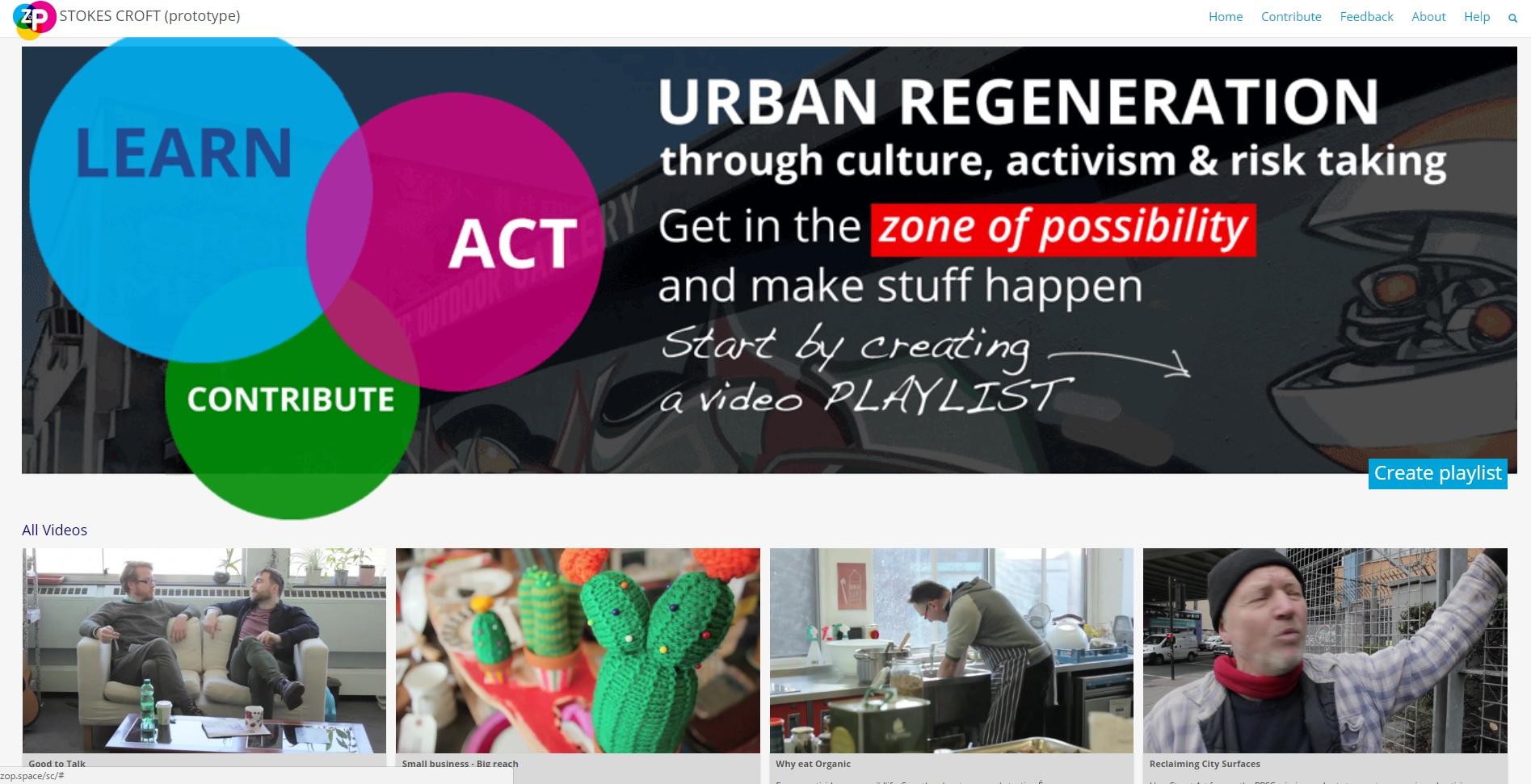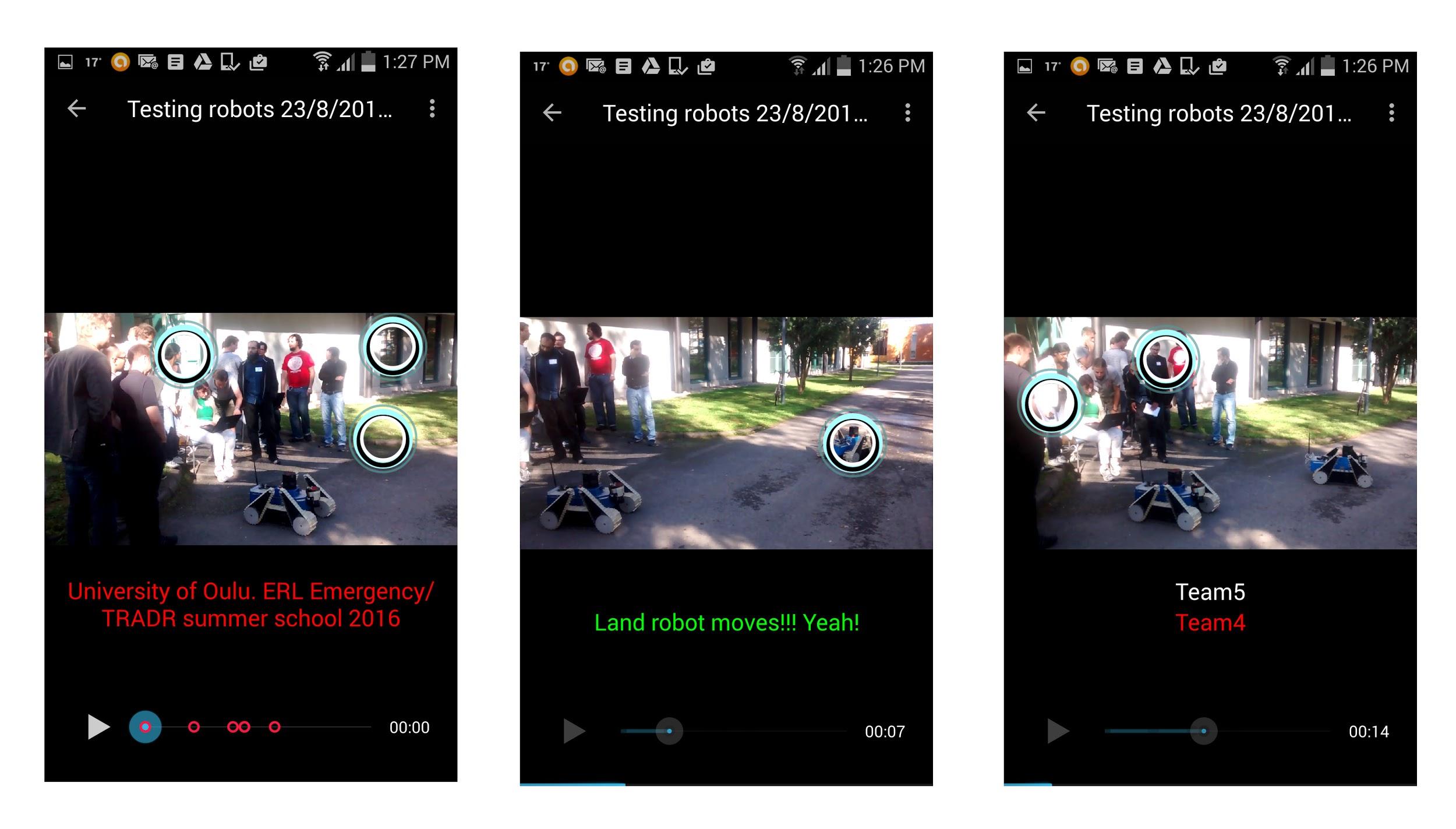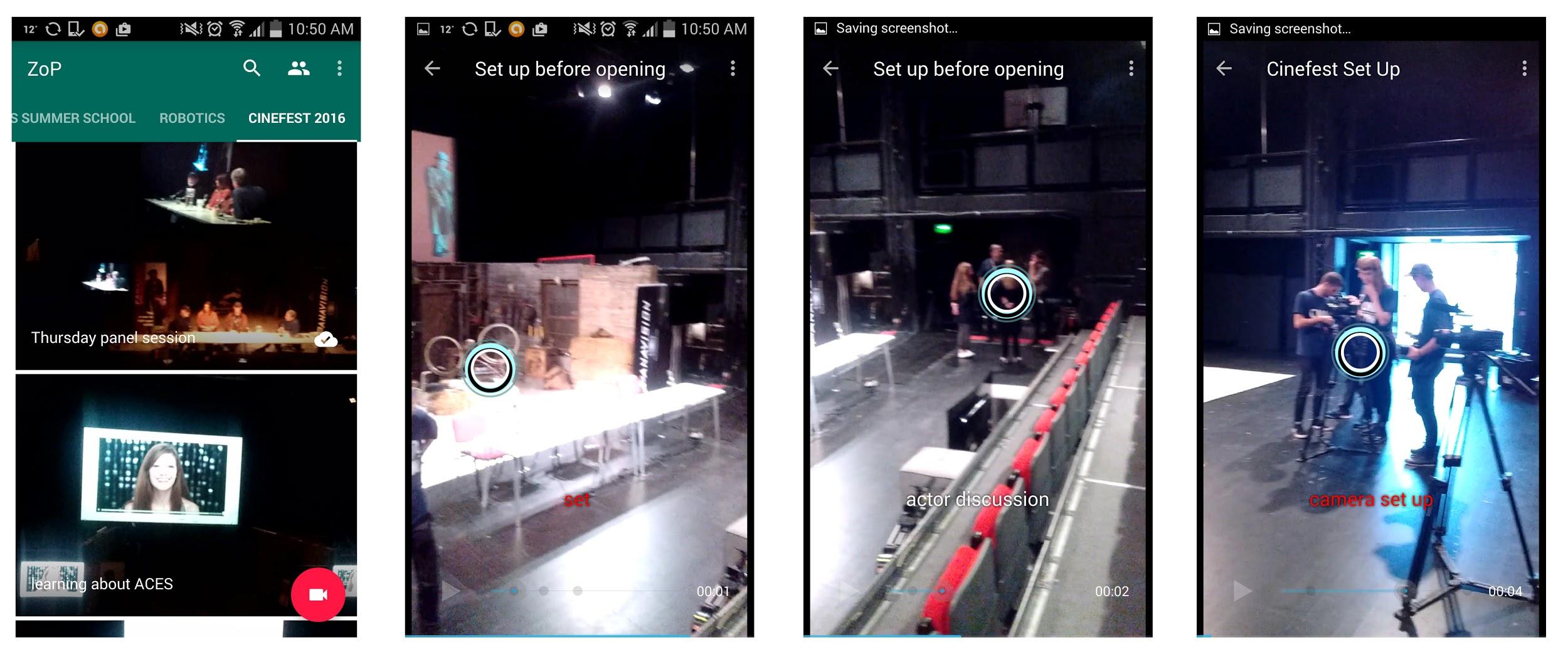Zone of Possibility
Highlights
-
We extend the Zone of Possibility concept coined by [1] view to include ‘digital artifacts’ that are shared as part of the Collective Knowledge and Contextual learning activities.
-
In a Zone of Possibility people connect and interact through a hybrid network of physical and technology-mediated encounters to co-create knowledge and effectively engage in positioning practices necessary for their work.
-
After using our ZoP tools (a mobile app and a website) in real professional settings we can confirm that these can be used as digital artifacts to mediate contextual informal learning at the workplace: by generating videos as learning resources to discuss with your learning community, finding examples of good practices, using local information or annotations added by the community, and extending your personal network by having situated conversations and debate with other professionals of the community.
Research challenge
A Zone of Possibility (ZoP) emerges when people and artifacts interact and professionals engage in social positioning practices while learning in informal workplace learning situations. As we describe below, the ZoP enables Collective Knowledge and Contextual Learning to dynamically emerge jointly through Social positioning. In general terms our vision of the Zone of Possibility has evolved to address aspects of the 2 major Learning Layers research areas mainly from the perspective of Collective Knowledge but also Contextual learning as additional perspectives.
We will describe how we meet aspects of these 2 Learning Layers research areas at two levels: (1) Theoretically through the ZoP concept (next section) and (2) practically through the application of two tools (ZoP app and ZoP SC site) in real contexts (see Use cases section). In our design approach (Design-based Research) these levels are inextricably linked from a theory through to impact on practice level.
Theoretical Contribution
For defining the ZoP as a concept we make use of several kernel theories. Social learning refers to a wide range of cultural-historical processes and practices where learners make use of social interactions to construct meanings and change behaviour [1], (missing reference). Networked learning is defined as “learning in which ICT is used to promote connections: between one learner and other learners; between learners and tutors; between a learning community and its learning resources” [2]. We extend the notions of ‘social learning’ and ‘networked learning’ with the concept of ‘hybridity’ derived from the literature (see Cook, 2015, Post-Vygotskian Perspectives on Learning and Research: A Critical Literature Review. Learning Layers report from UWE Bristol, UK. Available: https://goo.gl/vgaHmy). First we have a hybrid combination of formal and informal social structures in terms of power and control in an activity system (Daniels, 2008). What are the rules? How do I play the game? Who are the players? Daniels draws on the work of Bernstein to extend normal approaches to CHAT (Cultural-Historical Activity Theory), which can often take a very cognitive orientation, to include the ‘social’ (see Cook, 2015, p. 11 for details https://goo.gl/vgaHmy).
Briefly, Bernstein [3] deployed the concept of social positioning, which we find more helpful than ‘trust’, to refer to the “establishing of a specific relationship to other subjects and to the creating of specific relationships within subjects”. He relates social positioning to the formation of mental dispositions in terms of identity’s relation to the distribution of labour in society” [1]. We take as our starting point Daniel’s work, who considered only people in social positioning practices. However, we extend that view towards digital artifacts as well that are shared as part of learning activities. We propose that since professionals learn from each other and from the added credible resources in the working groups while developing the Collective knowledge in a Zone, the knowledge maturing in the groups may be enhanced by providing and orchestrating the recommendations for credible experts and resources from the whole network to increase the co-construction, learning and knowledge-maturing in the particular group. So, that learners can benefit from the relevant ideas of others and digital artefacts in the whole network (Possibility). Note that although Daniels coined the term ZoP [1], we have extended its scope and application by including the hybridity dimension and the use of digital artifacts.
There is a second dimension to hybridity in our ZoP vision: hybrid in terms of how physical and digital cultural-historically developed tools mediate the individual’s and group’s relation to the world where the competence to handle such tools is acquired in social settings through guidance from other persons or guidance from digital tools in a “50-50 partnership” [4]. In our vision, professional learning will be transformed by introducing tools (digital artifacts), which are designed for this ZoP approach of mediated learning in specific workplace contexts.
In summary, in a Zone of Possibility people connect and interact through a hybrid network of physical and technology-mediated encounters to co-create knowledge and effectively engage in positioning practices necessary for their work. This notion of ZoP makes a clear articulation of how Collective Knowledge is constructed at run time (i.e. when professionals/artefacts/tools interact and learn) and is for us key to defining Context (with the latter being overlapping activity systems that operate within the ZoP at run time). Collective knowledge and Context are emerge / are co-constructed at run time within the ZoP. The Zone of Possibility definition thus makes a distinction between the Zone as the structure (a hybrid network of physical and technology-mediated encounters blending socio-technical systems and the actual practice), and the behaviours that the Zone allows (calls for) (connect and interact, to co-construct knowledge, calls for orchestrating social supports - navigation and bridging aids, social positioning, positioning practices necessary for their work), and the resulting functions that the Zone takes as the Possibility (that learners can benefit from the ideas of others). The following figure represents a ‘zoom in’ of the ZoP in order to represent the social positioning and identity process:

Key concepts in the notion of the ZoP
Methods
On the one hand, the empirical data collected in the Healthcare context during Y1 and Y2 [5] was used to develop the ZoP meta-design principle - Respect Learners’ Zone of Possibility (http://ilde.upf.edu/layers/v/brn) during the Bristol Participatory Patterns workshop, More detail of the process can be found in [6] .
One the one hand, in Y4 we decided to explore how the ZoP approach could be used to extend some of the Learning Layers results to other workplaces (beyond Healthcare and Construction contexts) such as: Cultural industries, Urban regeneration and the Academia. For this reason, between January and October of 2016 three parallel co-design activities have been conducted with the main aim of developing further our Zone of Possibility vision. These co-design activities have involved meetings, interviews, discussions and focus groups between the main organizers of each pilot, end-users, designers, developers and researchers. Part of the feedback collected from these interventions have been used to develop a set of technical and non-technical requirements with the main aim of building tools to support the ZoP. As a result two prototypes have been developed: the ZoP mobile app and the ZoP Stokes Croft website (details presented below). However the detailed findings from the three pilots are still a work in progress due to the fact that ZoP.Space has been resulted as a spin off project of Layers during the 4th year.
Use Cases
Three pilots have been carried out in three different contexts but similar in terms of informal learning exchange: (1) Cultural literacy - ZoP Stokes Croft; (2) Creative Industries - ZoP Cinefest 2016; (3) Higher Education/Robotics Industry - ZoP Eurathlon Summer School 2016. These pilots have been developed to explore the key concepts of the ZoP framework. With this main aim in mind, two prototype tools have been co-designed: the ZoP app and ZoP website. On the one hand, the ZoP app is a mobile app allows users to record their learning experiences in a video format, share the result with their own groups, and collaboratively discuss through integrated annotations and discussion facilities. On the other hand, the ZoP website is an online hub that helps people move from curiosity, through learning, to action and contribution. The website contains videos by people engaged in successful urban regeneration. You can create a playlist to match your particular interests, hence nudging you towards socially valuable action.
The main aim of use of the ZoP tools in these settings is twofold:
-
Support Collective knowledge by helping citizens to participate with each other in groups (a Zone) calls for orchestrating social supports (via navigation and bridging aids) so that participants can benefit from the ideas of others (Possibility).
-
Use digital artifacts to support Contextual Learning: Videos generated by the users are used as informal learning resources to show findings, events at work or in a community project and can become the focus of situated conversations.
From the evaluation of each pilot we will understand the similarities but also the differences of these domains in relation of how informal learning has to be mediated through the ZoP.Space. Below is described the context of each pilot:
Urban regeneration within the Zone of Possibility
The ZoP Stokes Croft (ZoP SC) case uses the concept of the ZoP to allow the people of the inner city neighborhood of Stokes Croft in Bristol to share their experiences of self-driven economic, social and cultural regeneration. The ZoP SC is part of a spin off project (ZoP.Space see www.zop.space) that aims to explore how some of the results (including theories such as the ZoP concept, but also Layers tools such as Ach Rails, and the Social Semantic Server) can be used to support informal learning for Urban Regeneration through culture, activism and risk taking.
The ZoP-SC project acts as a venue for the presentation of examples and discussion of urban regeneration; showing how an unrecognized corner of a city can be reinvigorated from the street up. By using the ZoP SC website prototype (www.zop.space/sc) users can upload video clips, annotate points of interest at a specific time and location in a frame, share and discuss. In this way interesting we expect that the members of the Stokes Croft community use this site as a peer-to-peer learning tool to generate collective knowledge by uploading examples (in a video format) of informal learning actions and events at work or in a community project. These resources can become the focus of situated conversations associated to specific contexts. For instance: The founder member of the Stokes Croft China (https://www.prscshop.co.uk/) enterprise decides to create a video and share their experience showing how their team has created a unique business model in the Stokes Croft area. The aim is to use the ZoP SC site to generate debate, help others to relate their own initiatives (by using tags and semantic recommendations), use the site to collect knowledge, and help others in similar contexts to take benefit of this idea.

ZoP Stokes Croft prototype website main interface
Sharing outdoor learning experiences
euRathlon is a new outdoor robotics competition which invites teams to test the intelligence and autonomy of their robots in realistic mock emergency-response scenarios. The euRathlon/TRADR Summer School on Heterogeneity in Robotics Systems is designed as a five-day course to provide participants with a full overview and hands-on experience with multi-domain real robotic systems. The summer school is jointly organised by EURATHLON (www.eurathlon.eu) andTRADR (www.tradr-project.eu) EU Horizon 2020 and FP7 projects, respectively.
In this context, the ZoP mobile app has been used as a digital artifact to support the following actions: Participants of the summer school are organized in different teams. Each team has their own mission and have to prepare different tasks in order to win the challenge of the Summer School. The ZoP app enables to collect the knowledge from the different teams by allowing them to create videos in situ of their experiences with the robots. The result is a collection of videos that contains part of the knowledge generated by the Summer School participants. The Summer School participants (students and organizers) can add comments and discuss how the mission went (failures, good work, etc.) increasing the information/context associated to each video. For instance videos can be tagged as aerial vehicle, land, marine robot, control station… Videos can be used to reflect on their performance and also to exchange ideas with other teams. The organization can use the videos as a collection of good examples of outdoor learning experiences for next editions of the summer school.

Zop app being used during the euRathlon/TRADR Summer School 2016
Shaping your professional identity by learning from your peers
The Bristol International Festival of Cinematography (Cinefest 2016) is brought by the Centre for Moving Image Research at the University of West England (CMIR, UWE). Cinefest explores the practices, histories, theories, cultures and politics of moving image production, interaction and reception. The crew is formed by a group of high-expertise professionals (from the academia and the filming industry) but also by a group of volunteers that includes students and early-careers. Especially this is a very good opportunity for volunteers to learn different organizational aspects of a Cinematography festival (i.e. production, dissemination, organization of materials, documentary…). This is a very busy environment where people is distributed in different subgroups to cover the different aspects of the festival (see for instance examples in the images below: how a set was build, how actors were discussing or the cameras set up). In this context, the ZoP app was used during Cinefest 2016 to help volunteers to capture and document (in a format of short videos, see first figure below showing different videos collected during the festival) their informal learning experiences and share their knowledge with the rest of the group. Typically students or early-career are in a learning stage where they are positioning themselves in the professional world. By having access to different learning experiences (that contains different organizational examples of the festival) this group of learners have the opportunity to explore the knowledge acquired by the crew and use this learning to shape their own professional identity.

Zop App being used during Cinefest 2016
Reflections
As we have indicated, the research presented in this learning scenario will be further explored as a spin off project called ZoP.Space (see www.zop.space), the analysis of the scenarios described in the previous section is still a work in progress. We are having conversations and meetings with the main organizers of the three pilots to plan future co-design actions and collect further feedback, for instance: with the founder person of the People’s Republic of Stokes Croft organization; the producer of the Cinefest festival; or the project coordinator of the Eurathlon project.
The corresponding analysis will allow us to identify specific modes of use of our ZoP digital artifacts (i.e. Creation and production of learning resources in a video format, Curation, Ownership and identity, Partnership, Community building) this will be transformed in recommendations that will allow others to replicate similar projects. After observing how the tools have been used in real contexts we can state that at the moment the ZoP tools (mobile app and website) supports adequately the Collection of Knowledge by facilitating a digital space to support peer-to-peer learning. The derived result is a collection of videos, which are enriched with contextual information such as: the location (GPS coordinates) of the action, annotations added by the community (Remark, Suggestions, Good Work, Questions), and situated conversations in a format of forum associated to each video.
Our future plans also include to analyse these (and other) real uses of the tools to understand how the ZoP tools can: One the one hand to analyse the learning actions done by the user to generate a learning identity. And on the other hand, to include scaffolding mechanisms to support the social positioning of the learner. This means to capture information generated in the system by the community of users and provide recommendations by considering the actions, learning interests and profile of the learner.
Links:
Other places of the website where the scenario has been used/developed/supported
-
Tools connected to the scenario:
-
Methods through which scenario was created:
Further reading:
-
Cook, J., Lander, R. and Santos, P. (accepted) Urban regeneration within the zone of possibility in citizen led ‘hybrid cities’. In: Digital-Cultural Ecology and the Medium-Sized City, Bristol, UK, 01-03 April 2016. Available from:http://eprints.uwe.ac.uk/27652
Contributing Authors
References:
- H. Daniels, Vygotsky and research. Routledge, 2008.
- P. Goodyear, P. Avgeriou, R. Baggetun, S. Bartoluzzi, S. Retalis, F. Ronteltap, and E. Rusman, “Towards a pattern language for networked learning,” in proceedings of networked learning, 2004, pp. 449–455.
- B. Bernstein, “The structure of pedagogic discourse,” Class, Codes and Control, vol. 4, 1990.
- N. R. Shadbolt, D. A. Smith, E. Simperl, M. Van Kleek, Y. Yang, and W. Hall, “Towards a classification framework for social machines,” in Proceedings of the 22nd International Conference on World Wide Web, 2013, pp. 905–912.
- D. Holley, P. Santos, J. Cook, and M. Kerr, “‘Cascades, torrents & drowning’ in information: seeking help in the contemporary general practitioner practice in the UK,” Interactive Learning Environments, pp. 1–14, 2016.
- Y. Mor, J. Cook, P. Santos, T. Treasure-Jones, R. Elferink, D. Holley, and J. Griffin, “Patterns of practice and design: Towards an agile methodology for educational design research,” in Design for Teaching and Learning in a Networked World, Springer, 2015, pp. 605–608.
- J. Cook, R. Lander, and T. Flaxton, “The zone of possibility in citizen led ‘hybrid cities,’” 2015.
